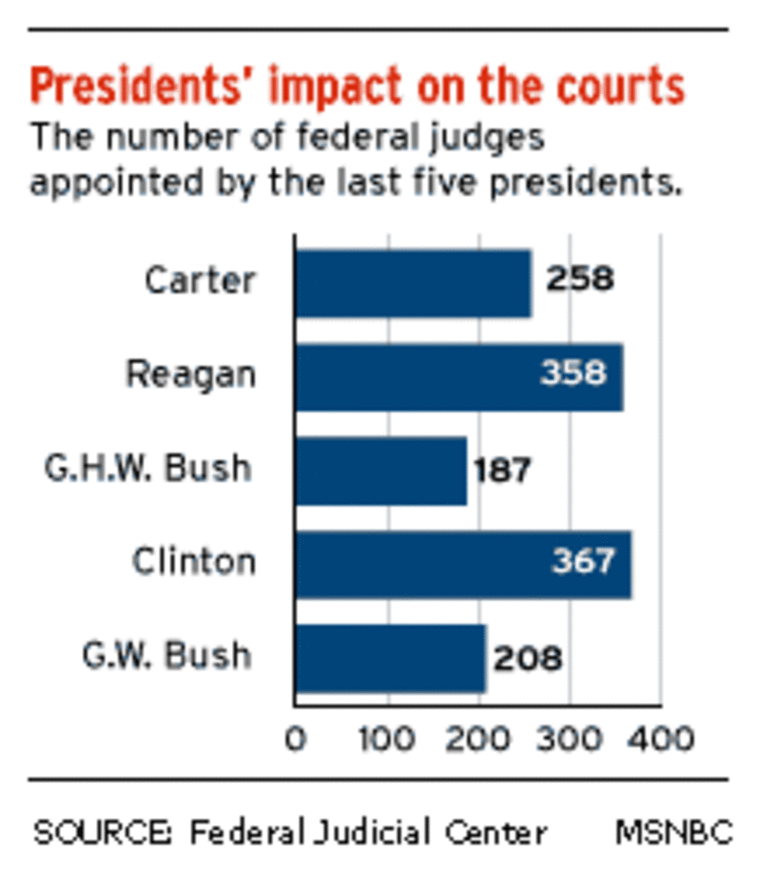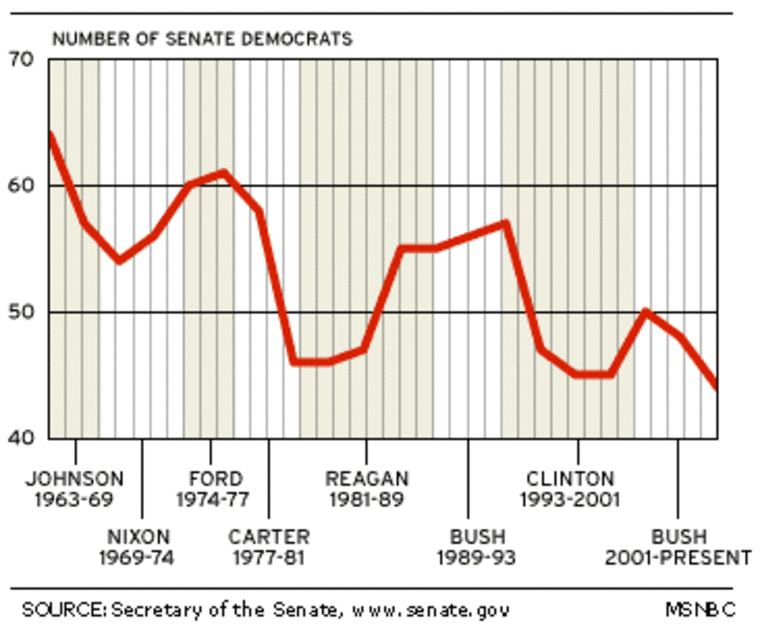The two Senate leaders, Sen. Harry Reid for the minority and Sen. Bill Frist for the majority, have each thrown down the gauntlet on President Bush’s judicial nominees.
Although negotiations continue to avert what is being referred to as the "nuclear option," Reid says that Democrats will continue to use the filibuster to kill nominations they find unacceptable.
Frist has vowed to change the filibuster rule so that Bush’s nominees can be confirmed by a simple majority of 51 senators. Frist is likely to trigger the showdown on the rules change next Tuesday.
Here’s a guide to the battle.
What is a filibuster?
A filibuster is a device by which a minority of senators, or even one senator, blocks the will of the majority by holding the Senate floor and talking.
This prevents the Senate from coming to a vote on a bill or a nomination. Even the threat of a filibuster can kill a bill or a nomination.
The Senate has a tradition of nearly unlimited debate, but the point of the filibuster is not to allow for more debate on the merits of a nomination or a bill, but to scuttle the nomination or force the majority to make changes in the bill.
In fact, Reid has said he would not accept an offer from Frist to have 100 hours, 200 hours or even more debate on any of Bush’s contested judicial nominees.
How can senators end a filibuster?
Under Rule 22 of the Standing Rules of the Senate, it takes a vote of 60 senators to end debate, or, in Senate parlance, “to invoke cloture.”
This means that 41 senators can stop a nomination from being brought to a vote, effectively killing it.
Is the filibuster mentioned in the Constitution?
No.
The Constitution does say, in Article I, section 5, that “Each House may determine the Rules of its Proceedings,” and the Senate’s rules have long permitted filibusters.
Those rules would also allow the Senate to change how filibusters are conducted or to abolish them.
When did the filibuster become a part of Senate procedures?
According to Congressional Quarterly’s “Congress A to Z,” the first full-fledged filibuster took place in 1841, over the issues of the appointment of an official Senate printer and the establishment of a national bank.
Does the Constitution require more than a simple majority vote for matters other than confirming presidential nominations?
In a few cases, yes, it does.

The Constitution requires a two-thirds Senate vote for ratifying treaties and for convicting an official who has been impeached by the House.
It also requires a two-thirds vote of both the House and the Senate to over-ride a presidential veto of a bill and to propose a constitutional amendment.
But Democrats now consider the 60-vote threshold the de facto super-majority requirement for confirming judicial nominees they deem "out of the mainstream."
Sen. Charles Schumer, D-N.Y., recently argued, "If you appoint a lifetime judge who has huge powers, there ought to at least be a strong leaning that they have some bipartisan support, that they have broader support than just 51-49."
Have there been previous filibusters of judicial nominees?
After a relatively short (four-day) filibuster in 1968, 24 Republican and 19 Democratic senators blocked a vote on President Lyndon Johnson’s nomination of Justice Abe Fortas to be chief justice.
The cloture vote was 45 in favor of ending debate to 43 opposed. Johnson withdrew the nomination after the failed cloture vote.
It is impossible to say with certainty whether the Fortas nomination could ultimately have mustered 51 votes.
The only three current senators who were serving in the body in 1968 (all Democrats) split on the Fortas vote: Sen. Robert Byrd of West Virginia voted to continue the filibuster of Fortas; Sen. Edward Kennedy of Massachusetts and Sen. Daniel Inouye of Hawaii voted to end it.
The Fortas nomination was unusual in its timing: Johnson, a lame duck, had nominated Fortas in June of 1968, only six months before the end of his presidency and the cloture vote did not take place until Oct. 1.
In 1986, Democrats engaged in a three-day debate on the nomination of William Rehnquist to be chief justice. But then-Democratic Leader Byrd denied it was a filibuster. The Senate voted for cloture, 68 to 31, and Rehnquist was confirmed that same day.
How have the Democrats been using the filibuster to block Bush's nominees?
Starting in 2003, the Democrats used filibuster threats to prevent ten of Bush's appeals court nominees from getting confirmation votes.
Democrats have allowed 36 to be confirmed. They have also allowed 172 district court judges (trial judges) to be confirmed.
Appeals court judges are the ones at stake since it is they who make far-reaching constitutional rulings, many of which never make it to the Supreme Court docket.

Why are Democrats using the filibuster?
Because they lack the votes to defeat Bush's nominees on a straight up-or-down vote.
Since Bush became president in 2001, Democratic senators have been unable to defeat any of his nominees on a simple majority vote.
With the number of Democratic senators having fallen from 56 in 1992 to 44 today, the filibuster is the only way for Democratic senators to block nominees of Republican presidents. Since federal judges have growing power over everything from same-sex marriage to regulation of land use, the stakes are very high.
And with at least one Supreme Court vacancy likely this summer, the Democrats see an even more compelling reason to hold on to the filibuster.
Were the Democrats' filibusters in 2003 and 2004 different from the Fortas and Rehnquist filibusters?
Yes, they were.
Prior to 2003, the Senate had never before had a series of cloture votes over two years, on ten different appeals court nominees, which blocked the nominees from having confirmation votes.
Also, the opposition to Fortas was bipartisan, while the opposition to Bush's nominees has been purely Democratic.
The only current Democratic senators to vote against the filibusters of Bush nominees are Sen. Ben Nelson of Nebraska and — on the nomination of Miguel Estrada — Sen. Bill Nelson of Florida.
How does Frist propose to change the filibuster?
He has already proposed a permanent change in Senate rules allowing for successively lower thresholds on successive cloture votes on a nomination, from 60 to 57 to 54 to 51.
But such a permanent change requires the support of 67 senators.
If Frist can not get enough support for that rules change, he will bring appeals court nominees Priscilla Owen and Janice Rogers Brown to the Senate floor for votes.
If Democrats filibuster those nominations, Frist would raise a point of order that any further debate was dilatory and not in order.
The presiding officer, Vice President Dick Cheney, would sustain the point of order, then submit the matter to the Senate for its decision.
A point of order is not debatable, therefore it can’t be filibustered.
If Frist has his votes correctly estimated, the Senate would then vote by a simple majority to sustain the point of order, debate would end, and the Senate would proceed to the vote on the pending nomination.
There is precedent for such a rule change: on Feb. 20, 1975, by a vote of 51 to 42, the Senate lowered the threshold for ending a filibuster from two-thirds of those senators present (67 if all 100 were in the chamber) to 60 senators.
Would Frist’s proposed change apply to bills or only to nominations?
Only to nominations.
In the past have Republicans used the filibuster to delay or defeat judicial nominees?
When Bill Clinton was president and Republicans had a Senate majority, from 1995 to 2000, they used non-filibuster delaying tactics such as anonymous holds — a device for a senator to prevent a nomination from reaching the Senate floor.
In many cases, they simply never held Judiciary Committee hearings to consider certain nominees, effectively blocking them from getting an up-or-down vote.
Despite the opposition of then-Majority Leader Trent Lott, a few GOP senators including Sen. Bob Smith of New Hampshire, did try to use filibusters to scuttle Clinton appeals court nominees Richard Paez and Marsha Berzon.
Smith was unapologetic: "Don't tell me we haven't filibustered judges and that we don't have the right to filibuster judges on the floor of the Senate. Of course we do. That is our constitutional role," Smith declared on March 7, 2000.
Smith justified his filibuster by citing the cases of President George H.W. Bush’s judicial nominees Kenneth Ryskamp and Lillian BeVier, whose nominations died in 1992, the final year of Bush's term, due to Democratic foot-dragging.
Eventually 40 Republicans joined with 45 Democrats to stop Smith’s filibuster and both Paez and Berzon won their confirmation votes.
How has Bush counteracted the Democrats’ filibusters of his nominees?
Using his power under Article Two, section 2 of the Constitution, Bush made two recess appointments to the federal bench: William Pryor, whose recess appointment expires at the end of this year and Charles Pickering, who retired last year.
